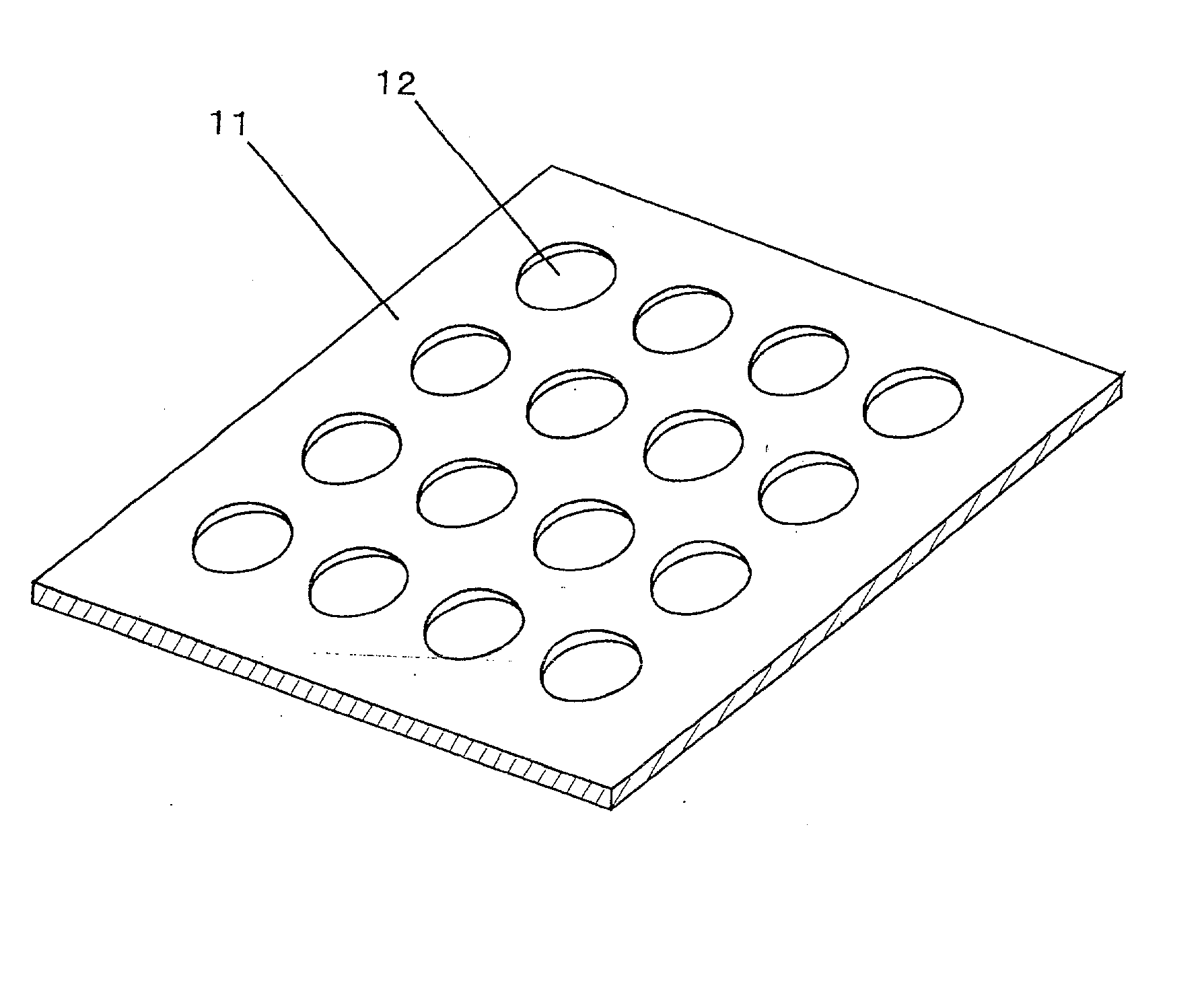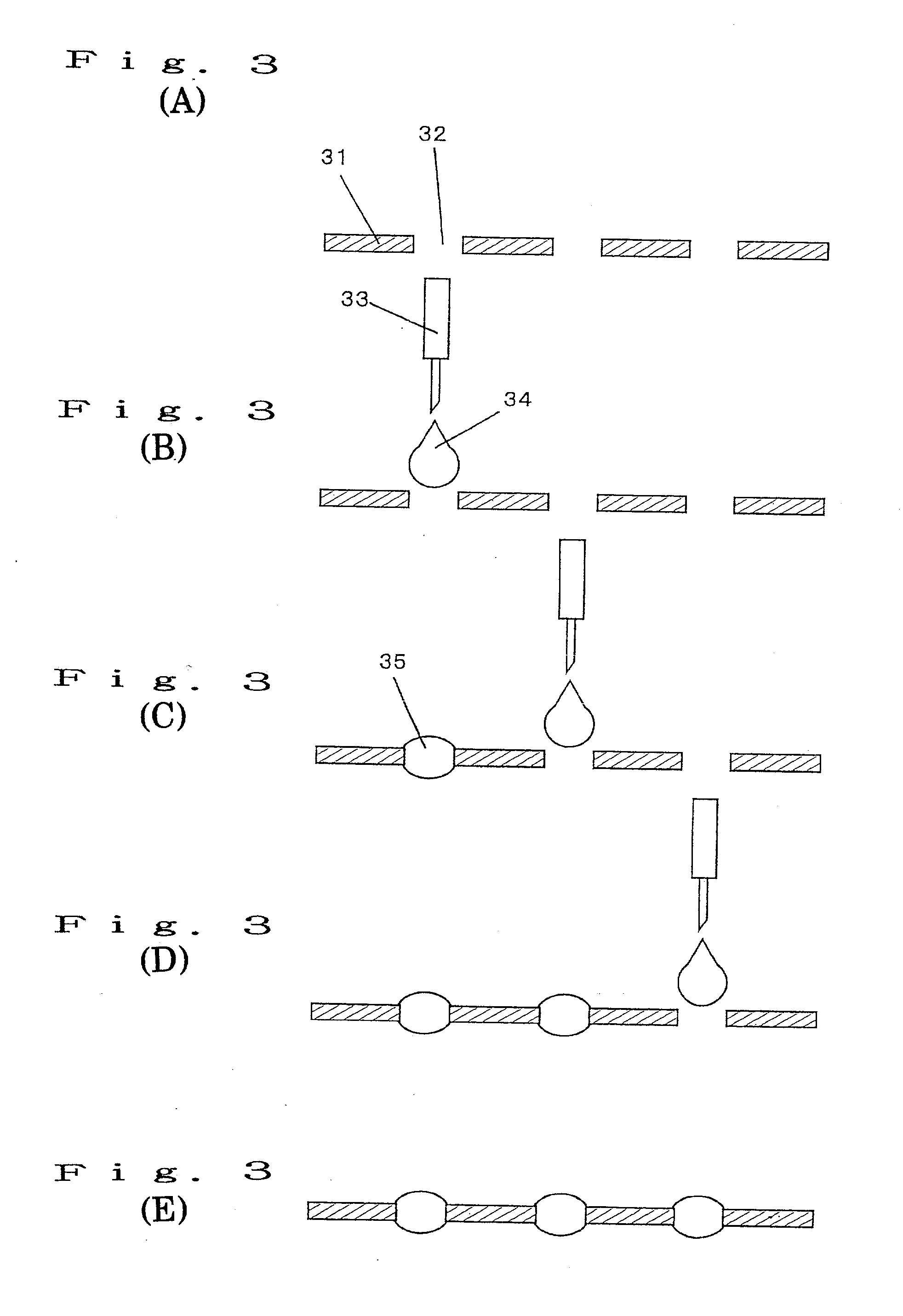Method of manufacturing microlens array and microlens array
a manufacturing method and microlens technology, applied in the field of microlens arrays, can solve the problems of inability to produce microlens arrays with a focal length about the same as the diameter of the lens, and the inability to realize high-performance optical coupling elements
- Summary
- Abstract
- Description
- Claims
- Application Information
AI Technical Summary
Problems solved by technology
Method used
Image
Examples
first embodiment
[0060] (First Embodiment)
[0061] FIG. 1 is a perspective view showing a microlens array according to a first embodiment of the present invention. As shown in FIG. 1, the microlens array in the first embodiment comprises a substrate 11 in which a plurality of through holes are provided and convex lenses 12 arranged on each of the through holes in the substrate 11, wherein a diameter of each of the convex lenses is from about a several tens of microns to about a several millimeters.
[0062] The convex lenses 12 have light transmitting properties and they are formed from a curable liquefied resin material or a thermoplastic material or a glass material that can be cured on the substrate 11.
[0063] FIG. 2 is a cross-sectional view of the microlens array according to the first embodiment of the present invention described above with reference to FIG. 1, showing a state wherein the convex lenses are respectively disposed at the through holes on the substrate 11.
[0064] The microlens array acco...
second embodiment
[0069] (Second Embodiment)
[0070] FIGS. 3A to 3E are illustrations for a method of manufacturing microlens array according to a second embodiment of the present invention. The method of manufacturing microlens array of the second embodiment in the case of using a glass material for a substrate 31 and an adhesive resin material having light transmitting properties as a material for lenses 35 as shown in FIGS. 3A to 3E will be described in detail below.
[0071] As shown in FIG. 3A, through holes 32 are formed on a substrate 31 precisely by employing various fine processing techniques. The fine processing techniques to be employed may be an ultraprecise cutting, a laser processing, a focusing ion beam processing, a laser etching, a microdischarging, an electron beam writing.
[0072] Then, as shown in FIG. 3B, an adhesive material 34 is dropped from drop nozzles 33. A viscosity of the adhesive material 34 is so selected that the adhesive material stays in the through holes 32 without falling...
third embodiment
[0074] (Third Embodiment)
[0075] A method of manufacturing microlens array according to a third embodiment of the present invention that is illustrated in FIGS. 4A to 4C will be described below. The process illustrated in FIGS. 4A to 4C is different from that illustrated in FIGS. 3A to 3E by a nozzle unit 44 that is formed by integrating a plurality of nozzles in order to shorten a time required for the production. By the use of such integrated dropping nozzles 44, a microlens array comprising the plurality of convex lenses can be two-dimensionally produced in a remarkably short period and effectively.
PUM
| Property | Measurement | Unit |
|---|---|---|
| sizes | aaaaa | aaaaa |
| contact angle | aaaaa | aaaaa |
| transmittivity | aaaaa | aaaaa |
Abstract
Description
Claims
Application Information
 Login to View More
Login to View More - R&D
- Intellectual Property
- Life Sciences
- Materials
- Tech Scout
- Unparalleled Data Quality
- Higher Quality Content
- 60% Fewer Hallucinations
Browse by: Latest US Patents, China's latest patents, Technical Efficacy Thesaurus, Application Domain, Technology Topic, Popular Technical Reports.
© 2025 PatSnap. All rights reserved.Legal|Privacy policy|Modern Slavery Act Transparency Statement|Sitemap|About US| Contact US: help@patsnap.com



